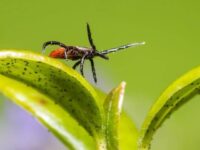This post contains affiliate links. If you click on a link and make a purchase I earn a commission at no extra cost for you.
Geraniol is an essential oil, a natural compound that many plants produce to protect themselves from feeding insects. It can be used on humans and pets to provide reliable protection against ticks, mosquito fleas, and other nuisances. The Geraniol natural repellent does not get into the bloodstream but protects purely by external action through a smell that repels many blood-sucking insects.
The substance is also used in the perfume industry and occasionally for aromatherapy applications.
What is geraniol
Geraniol is a chemical compound, it is s a monoterpenoid and alcohol. The chemical formula is C10H18O. It is also known as Lemonol or beta-geraniol. In its pure form, it is a colorless or slightly yellowish liquid with a floral odor, which has low solubility in water, but it is soluble in most organic solvents.
Geraniol is the main constituent of rose oil, palmarosa oil, and citronella oil. It is also present in small quantities in geranium, lemon, and other essential oils. Geraniol is used as a mosquito, tick, mite, and flea repellent. It has antimicrobial and fungicidal applications as well.
Geraniol is also found in Nasonov pheromone, a substance made in the scent glands of honeybees. They use it to mark nectar-bearing flowers and to mark the entrances of their hives.

Extraction of geraniol
Geraniol is a naturally-occurring essential oil that is found in plants. The largest quantities are contained in palmarosa oil, the oil of the geranium plants, and the rose plants. Geraniol is also found in lemongrass, coriander, laurel, nutmeg, basil, lemons, blackberries, oranges, cilantro, blueberry, carrots, and ginger.
Geraniol can be obtained by distilling the essential oils of the above plants. But this is an expensive process and only applied in scale for the perfume industry.
Nowadays it is much easier and cheaper to synthetically manufacture geraniol.
How does Geraniol act
Geraniol is mainly used as a mosquito and tick repellent to be applied diluted to skin, fur or clothing. Other target arthropods include ants, bed bugs, beetles, cockroaches, crickets, fleas, flies, stink bugs, and termites. It is also used against bacteria, including E. coli, Salmonella spp; and fungi, including Aspergillus spp.
- The main mode of action of geraniol is that it repels insects by interfering with the sensory and olfactory organs. In simple words: Bugs can not smell their victims!
- Geraniol disrupts cell walls, membranes and destroys the chitin shell of parasites and interferes with their respiratory system killing. Humans and pets have no chitin and remain unaffected by this effect.
- Disrupts insect neuronal activity and mediates its action by acting on acetylcholinesterase and the octopaminergic system, thereby disrupting neuroelectric activity.
Mode of application
Personal Repellent
Geraniol is an effective alternative to conventional synthetic repents. It is available as oil to repel insects. As a tick and insect repellent, it is effective for 2 to 4 hours depending on the type of parasite.
Use diluted in a carrier oil. Do not use pure geraniol as this can cause skin irritation.
Mixing 10 to 20 drops in 1 ounce of base oil such as jojoba, almond oil, avocado oil or coconut oil will work wonders. Especially mixing it with coconut oil will make a good repellent against tick and mosquitos.
It is also readily available in natural insect repellents. Bracelets to be worn on the wrist or ankle are a popular method of protection.
For dogs and cats
Collars, spot-on, sprays, and shampoos that contain geraniol as an active ingredient against ticks and fleas are available to buy in pet stores or online.

Side effects
- May cause allergic reaction
- It can cause dermal irritation in people with sensitive skin such as irritation or skin discoloration.
- Avoid contact with the eyes will cause eye irritation.
Advantages
- A natural product found in plants
- Smells great, sweet, floral, and citrusy. So it works well in perfumes and creams.
- Compared to other agents well tolerated.
- Geraniol is a naturally occurring insect repellant. It is very effective in repelling mosquitoes, house flies, stable flies, and household pests such as cockroaches, fleas, bed bugs, ticks, and fire ants.
- It is also effective as antimicrobial and antibacterial.
- No health risks for humans and animals
- It is harmless to aquatic organisms
Disadvantages of geraniol
- Is considered a weak contact allergen
- May cause allergic contact dermatitis in people who are sensitive to it.
- Not as effective as DEET or Picaridin
- Not everybody likes the smell
- Some dogs don’t like the smell either
- Not suitable for Asthmatics
Geraniol – a good natural alternative
Geraniol is a good and very tolerable essential oil that can be used to repel ticks in humans and pets. Although there is no 100% protection, as an insect repellent, it is more effective than other natural repellents.
As there are also almost no side effects known, it is a good choice if you want to avoid chemical alternatives. It is also safer to use as compared to other insect repellents. In rare cases, though it may cause irritation and allergies.
It can be combined and mixed with other natural insect repellents. You can also use it in recipes to make home-made tick repellents adding it to carrier oils such as coconut or neem oil to increase protection.
When used correctly, small doses are sufficient to produce effective products against parasites such as fleas, ticks, mites or hair lice. This makes it the ideal active ingredient for use in and around pets.
It is volatile and biodegrades readily in soil, air, and water. So, it is not harmful to the environment and other living organisms.
Sources and more to read:



